
by Charles Bonniwell | Jun 26, 2022 | Main Articles
by Charles Bonniwell

Rich History: The Denver Country Club possesses one of the oldest golf courses in Colorado and the club itself is the oldest country club west of the Mississippi, founded in 1887. It opened in 1905 and was designed by James Foulis, although a number of different golf designers have done renovations to the course over the years. The 18-hole, private course is 7,039 yards at its longest tees with a par of 71.
One of the oldest and most prestigious amateur golf tournaments in the world returns to the Denver Country Club (DCC) for the sixth time on July 6-9, 2022. The Trans-Mississippi Amateur was first played in 1901 and came to the Denver Country Club in 1910. Prior winners of the tournament include Jack Nicklaus, Ben Crenshaw, Johnny Goodman, Bryson DeChambeau, and in recent years, Colin Morikawa and Will Zalatoris. This year’s field is to include 102 of the world’s top 200 amateur golfers, according to Gary Potter,

DU Star: Coloradan Cal McCoy tied for seventh place in the prestigious Trans-Miss Amateur Championship in 2021. He will compete in this year’s tournament as well.
local tournament chair and DCC member.
The Denver Country Club was formed in 1887 and is the oldest country club west of the Mississippi River. Originally located at Overland Park as a club focusing on horse racing, it was one of the original 15 clubs that formed the Trans-Mississippi Golf Association. In 1901 the club changed its name from the Overland Park Association to the Denver Country Club and in 1905 moved its location to its present Cherry Creek location.
The Trans-Mississippi is part of the recently formed Elite Summer Amateur Series composed of seven of the oldest and well-known amateur tournaments in the nation representing 680 years of championship golf. The other tournaments include the North South Amateur, the Pacific Coast Amateur, and the Northeast Amateur.

Local Favorite: Jackson Klutznick was the Junior Golf Alliance of Colorado Tour Championship winner in 2018. He was also the 2019 Denver Country Club Men’s Champion. He is the son of John and Heather Klutznick, Denver Country Club members.
When the DCC hosted its first Trans-Mississippi championship in 1910 amateurs generally reigned over the world of golf. The DCC also hosted at the same time a tournament for professionals, but it was subsidiary to the amateur championship. Club President Frank Woodward was de-
termined to rule American golf. He felt he had to host the major championships at the DCC’s new course which was touted as one of the best and toughest in the country with The Golfer’s Magazine calling it “one of the best tests of skill and accuracy in the United States.”
Back in 1910, such tournaments were major social occasions with lavish balls held at the club and spectacular parties at private residences. The course proved every bit as difficult as advertised. The Denver Post noted that “players who should have done the course in less than 80 were running up scores of 100 to 120.” Only three holes of that original course remain with parts washed out in a flood in 1912 at the start of the Western Amateur held that year, and partially ruining Woodward’s plans.
The DCC has had a veritable who’s who of golf architects revise the course over the last 100 plus years, the most recent being Gil Hanse, who has also revised various US Open venues such as The Country Club outside of Boston and the Los Angeles Country Club.
One of the highlights of the 1910 Trans-Mississi

Elite Amateur Series: The 118th Trans-Mississippi Amateur Championship will be played July 5-9, 2022 at the Denver Country Club.
ppi was the rise of 19-year-old DCC youth Larry Broomfield who made it to the semi-finals against some of the best players in the country. He would dominate golf at the DCC and in Colorado for decades thereafter.
For the 2022 Trans-Mississippi, perhaps the greatest male DCC golfer since Larry Broomfield will be playing, 20-year-old Jackson Klutznick, the son of DCC members John and Heather Klutznick. A sophomore at Emory University in Atlanta, Georgia, he is the leading player on the university golf team and a finalist for the Jack Nicklaus Award for top collegiate player in NCAA Division III schools. He is a two-time DCC club champion and Kent Denver graduate. Klutznick has won various golf tournaments across Colorado and the United States. He first made the local papers news when at age 13 he drove a golf ball 357 yards at the DCC.
He will be facing such top players as Travis Vick who won the low amateur medal at the recent US Open at The Country Club outside of Boston, and Texas A&M star Sam Bennett. Locally another strong competitor will be Cal McCoy from Highlands Ranch who played for Denver University for three years before transferring to the University of Arizona. He finished tied 7th at last year’s Trans-Mississippi at the Windsong Farm Golf Club in Minnesota.
The tournament will be a 72-hole stroke play with the final two days cut to the top 54 players. The winner will earn points that will be applied to the PGA tournament in the fall in Bermuda.

by Regan Bervar | May 20, 2022 | Main Articles
“Fraud is the daughter of greed.”
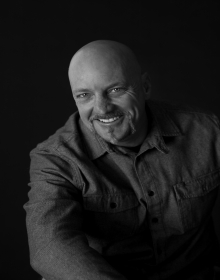 by Luke Schmaltz
by Luke Schmaltz
The continuous exchange of money for goods and services is a 24-hour, seven-day-a-week fact of life. The neurology of commerce pulses onward like the relentless heartbeat of the human race. But, like seagulls swooping down on a fishing boat, like termites eating at the frame of a house, like flies laying eggs in an open wound — the fraudsters and scammers are at work ’round the clock, attempting to gain access to what is yours in order to make it theirs.
As technology becomes more and more sophisticated, so too does the savvy of hackers and scammers. Here are a few of the top signs of trouble which are afoot today.
Job Robbers

Savvy Scammers: Be alert for warning signs of a scam. Rip-off artists are working to access what is yours and make it theirs.
The cruelty of a rip-off artist knows no bounds, and if you think no one would try to scam a person who is simply trying to better their position in life by looking for a job — think again.
This scheme starts with a text message offering the recipient a job with a reputable company. This is typically described as a nonspecific position such as “customer service representative.” The person on the other end will say they saw your profile on a job board such as Indeed or ZipRecruiter.
Once you express interest, they will say the hiring manager will need to interview you via Google Hangouts. During the “hangout” they will inform you that you have been hired and proceed to request personal information for your background check, paycheck direct deposit, etc.
Takeaway: Any job offer which comes to you via text from an unknown person should be considered a scam.
Amazombies

Urgent Amazon Bluff: Be wary of urgent emails, text messages, and phone calla about your Amazon account.
One of the top drivers of perpetual, sleepless commerce is Amazon. The online behemoth of retail owns a massive market share so naturally; Amazon scams are proportionately prevalent. In fact, the top news item in this arena is that Amazon scams are up 500% from last year.
Urgent communications about your Amazon account may arrive via email, text message, or phone call. The text or script will say there is a “problem” and that your account must be verified and the matter is “urgent.”
Clickable links will lead you further into the phishing web, as will calling a phone number provided by the message.
Takeaway: Always access your Amazon account via your device and initiate communication from the website chat or messaging portals. Amazon does not send emails or text message with “click here” prompts.
I’ll Be You
People who post notices online for missing pets, items for sale, or requesting specific makes and models of cars or musical instruments can be targeted by scammers pretending to be on the lookout for fraud.
The person will contact you and express concern that they want to “make sure you’re not a scammer.” In order to proceed, they will then send you a verification code from Google Voice and ask you to read it back to them.
In doing so, they are capturing your unique voice imprint and setting up a Google Voice account in your name so that they can continue to perpetuate what they claimed to be wary of.
Takeaway: Never read back verification codes to anyone over the phone.
The Sky is Falling

Phony Phone Calls: Charlatans ask you to read back verification codes to capture your voice imprint and make it their own.
The rise in extreme weather events and the vigor with which the news reports them has viewers highly attuned to the suffering of others.
Scammers see sympathy as weakness and as soon as a hurricane gets named by the World Meteorological Association, a “relief fund” in its name is poised to be launched the moment the storm makes landfall. The same is true with wildfires, tornadoes, and the typhoons.
Charity organizations and relief efforts are monitored by watchdog groups such as the Better Business Bureau, CharityWatch, and CharityNavigator. If you are contacted and asked to donate, you should first verify the legitimacy of the charity through at least one of these organizations. Also, you can Google the charity’s name followed by the word “scam” and any reports of fraudulent activity will come up.
Takeaway: A legitimate charity will never apply a high-pressure hard sell when asking for a donation.
The Metacurse
The latest trend in digital lifestyles, while buzzing with fascination and excitement, is rampant with new opportunities for scammers looking to swindle distracted, googly-eyed gawkers.
This relatively new construct using headsets, virtual reality, and avatars in place of analog interaction has an “emperor’s new clothes” appeal for fraudsters. The avatars of coworkers, customers, customer service reps, and sales agents can all be easily impersonated by hackers.
Interaction based solely on digital identities places all participants in jeopardy of being easily played.
Takeaway: If it seems too unreal to be true, it probably is.

by Regan Bervar | May 20, 2022 | Main Articles
Ground Floor Opinions About Denver’s Meow Wolf Installation
by Luke Schmaltz

Meow Wolf takes visitors through a journey of convergence through the multiverse — a confluence of four separate worlds which collide around the viewer’s senses.
Meow Wolf Convergence Station sits at the crossroad of Colfax Ave. and I-25 like a fortress of the extraordinary — a labyrinth of mind-bending worlds meant to immerse, inspire, and entertain.
The exhibits and attractions therein await to bombard visitors with an unmapped, unpredictable miasma of madness without warnings, wherewithal, or significant signage. The experience lands somewhere between interactive art museum and over-hyped tourist trap. Similar to the institution’s original location in Santa Fe, NM, and the subsequent installment in Las Vegas, NV, this destination is dripping with the artistic input of hundreds of contributors and collaborators — many of which are residents of the Mile-High City. The organization’s official statement is that among the 300+ artists who collaborated, exactly 110 were from Denver.
Whether Denver’s Meow Wolf installation is truly a monument to modern and postmodern art or a sensory overload amusement park on audio and visual steroids is a matter of opinion. These can range from positive to critical to indifferent — depending on one’s perspective and their position on the merits of big business converging with independent artists.
The Repurposing Diorama Maker
Scott Hildebrandt — aka Mr. Christmas — is a Denver-based artist who combines his love for miniatures and holidays into a unique brand of playful creativity. Hildebrandt applied to collaborate with Meow Wolf in 2017 and waited for two years before definitive plans to get to work were made. “In the summer of 2019,” he begins, “I began submitting plans, diagrams, specs, and requirements of the space that I would need. Then, over the rest of 2019, there were several meetings with lighting and sound teams to define my needs for this project,” he explains. “There was quite a bit of momentum at the beginning of 2020, until the pandemic halted everything. [By] late summer of 2020, I was able to finally get started by collecting materials mocking up my design. By fall, I was assembling and designing my concepts and building the framework. At the beginning of 2021, I was in full production mode with a hard fast deadline of May 1st to meet final inspections. For four months straight, I worked seven days a week, around 8 to 14 hours a day to make that deadline.”
Hildebrandt says he considers Meow Wolf to be a hub of artistic merit and an outstanding Denver treasure. “I truly believe that Convergence Station is an art installation and definitely an

Scott Hildebrandt specializes in miniatures and dioramas but his Meow Wolf collaboration is a macro-installation of his work.
art experience,” he says. “The whole venue encourages
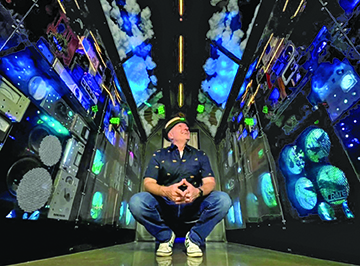
Scott Hildebrandt’s Meow Wolf installation is a life-sized diorama made of repurposed materials.
playful curiosity and invokes imagination with art in a way that no other museum or gallery can. Denver is truly blessed to have something like this in their very own backyard. Not only is it good for Denver, but it is very good for the Denver art scene. Convergence Station showcases 110 Denver artists and shows how strong the Denver arts scene really is. Since I’ve started my journey as a full-time artist, I have had the opportunity to meet so many wonderful artists here in Denver. On any given First Friday, you can explore galleries all over Denver showcasing both new and old artists and be truly amazed at the talent that we have here,” he says.
The Insider
Mar Williams is a Denver illustrator who became involved with the Meow Wolf corporation in 2016 and was subsequently part of a 2019 class-action lawsuit against the company for discrimination. Williams is transgender, and alongside several other individuals had complaints against the company (a B Corporation) for unfair practices toward employees based on gender.
While the matter was resolved in early 2020, Williams maintains a distinctive opinion about Meow Wolf’s role in the arts community. “I’d like to include my earlier quote to Westword, which safely summarizes a lot of my perspective,” Williams says. “My hope is that they do more to lift individual artists than to absorb them.”
Williams goes on to explain, “To expand on a piece of that; Is Meow Wolf authentic art? I think it’s important to separate the brand from the art for that question. Maximalism and the ironic sincerity of meta modernism are ultimately hollow when coming from a brand, because the vulnerable human point of self-reference isn’t sincere or simply doesn’t belong to it. It’s like the Wendy’s (fast food chain) twitter account being edgy. It doesn’t mean anything. I think there’s plenty of authentic art and artists in that space, and while the bigger, flashier, more profitable container may drive more traffic to it, the container isn’t the art, and corporations aren’t collectives.”
The Multimedia Creative
While artist Dice 51 currently lives in Denver, he is originally from Albuquerque, NM. While he begins most of his work with pens on plain paper, that’s hardly where it stays. The end result of his continued attention to any particular piece can result in p

Mar Williams was one of the first Denver artists to become involved with the corporate megalith, and has distinct opinions on art that is purveyed by big brands.
ens, pendants, wood stacks, laser-cut wood-stained pieces, and more.
Dice’s native New Mexican heritage prompted him to apply to be a Meow Wolf collaborator. “I first started working with Meow Wolf through the events team. I would organize live art and vendors for certain shows at the Santa Fe exhibit, bringing in artist friends from around the country to display their work,” he explains. “I grew up in Albuquerque, so as a local artist in New Mexico I knew I wanted to contribute to Meow Wolf. Eventually with [some] help I was able to apply for the Denver exhibit,” he says. “I spent close to three months working directly on my piece for the exhibit, and the application process was about two years long. I did most of the design and building in the months before installation, then spent two weeks installing the piece.
Dice contends that the experience was unique but positive. “I’ve never worked on something so big,” he begins. “Luckily, I got full creative control once my proposal was accepted, so I could really dive into the creative process without any outside influences. There’s so many people that were involved that I still haven’t met. The result was amazing, I still stumble on work that I’ve never seen there whenever I get a chance to wander.”
Part of Meow Wolf’s brand is intertwined art installments without signage or explanation, leaving uncredited collaborators to take solace in the fact that they got paid to be a part of something big and beautiful. While every artist is credited on the Meow Wolf website, some were determined to put their personal stamp on their work so that curious visitors could find them if necessary. “I wish I was able to attach my name to my project more,” Dice says. “I had to get creative with it, so I hid it all throughout the piece and had a full write up displayed with my pieces in the giftshop. Some other artists fou

Dice 51 next to his Meow Wolf collaboration. The New Mexico native-turned Denver resident relishes his experience contributing to Meow Wolf Convergence Station.
nd great ways to get their name on their piece. I know one had a giant symbol made of QR codes in his room, and the QR codes lead to his website. I think something like that is the best move, something subtle enough it doesn’t take away from the art, but direct enough to actually connect to the millions of people who go to the exhibit. I definitely see Meow Wolf as an art installment. It’s like a giant art piece that you can walk inside of and be a part of. From the exhibit as a whole, to the tiny details hidden throughout, the entire experience is led by artists.”
The Outsiders
Speaking of galleries, one local artist who has curated a prominent presence among the First Friday visual art crowd goes by the moniker of W. Max Thomason. He holds the Meow Wolf phenomenon in ho-hum regard, saying, “Simply put, it is commercial art. No matter what title, label, and/or designation you give it, it is only commercial art. It is not fine art. Nor do I think it should ever be considered fine art. In all fairness though, having never spoken with the designers, creators, or decision makers I cannot say if it was ever meant to be considered fine art, but I do think it should not be viewed or judged as thus,” he contends. “If it inspires, motivates, or speaks to someone, fantastic. It has never done so to me. I think [the] assessment of a modern, repackaging of amusement park-style entertainment is a fair and accurate elucidation.”
Meanwhile, while most of the art world is in some way concerned with Meow Wolf, there are those who remain blissfully unaware of any such phenomenon. One such individual is Abe Brennan — a Denver musician and illustrator, enjoying a post-2020/2021 windfall of design work creating T-shirt art for bands. When approached about Meow Wolf, he blinked, shrugged and said, “Huh? Meow what? Never heard of it.”
Regardless, should you aspire to experience this immersive experience firsthand, be prepared to pay a hefty admission fee. Tickets are priced at $44 to $49, depending on age. Get your money’s worth by choosing an early arrival time and plan on being there for at least a few hours. Then, prepare yourself for a wild, nonstop hyper-stimulating, one-of-a-kind ride. Whether you’re an artist or a spectator, this destination has something for everyone.

by Charles Bonniwell | May 20, 2022 | Main Articles
But Is It Really?
by Charles C. Bonniwell

Who’s The Real King? The Denver Post insinuated that Glendale is the Car Theft Capital of the U.S. in order to hide the fact that Denver by almost all metrics is the title holder.
Glendale brands itself as “Rugbytown USA,” the capital of rugby in the United States. Forty years ago, a book by Jack E. and Patricia A. Fletcher about Glendale was titled “Colorado’s Cowtown.” Today, thanks to a front-page article on “How did Colorado become one of the worst states for vehicle theft?” by John Aguilar, featuring a picture of Glendale City Hall which went national on MSN, Glendale is being called the auto theft capital of America.
How did a town which has relatively few auto thefts from its residents and even fewer cars stolen by its residents become the auto theft capital of America? Easy, stats. According to the National Insurance Crime Bureau, Colorado is the top state for per capita auto thefts with more than 500 vehicles per 100,000 residents. Glendale, in turn, has more auto thefts per resident than any other city in Colorado.
But Glendale, over the last four months through April, 2022, only had 79 auto thefts total which is not even a good night of auto thefts in metro Denver, which according to the Colorado Metropolitan Auto Theft Taskforce (C-MATT) the Denver metro area has on average nearly 100 vehicles stolen every day.
The article does sheepishly admit that the “unenviable designation is somewhat misleading given Glendale’s daytime influx of office workers and shoppers versus its residential population of approximately 5,200.”
“Somewhat misleading?” Glendale has a massive office and retail base compared to a small population. Pre COVID-19 pandemic, over 80,000 to 100,000 people per day came to Glendale according to Glendale city officials. The car thieves come overwhelmingly from metro Denver and steal cars of residents of metro Denver. As a practical matter since Glendale has only two single family homes, a large number of its residents take public transportation or ride shares and don’t even own cars to steal.
Why then stigmatize Glendale? Denver itself is, in fact, the auto theft capital of the United States by most metrics, but The Denver Post does not want to highlight that fact. It, in fact, can’t since it depends on the City and County government for subsidies to keep it profitable. Thus, talk about Glendale and its 79 car thefts in four months and skip over the thousands in Denver over the same period of time.
“It’s nothing new,” said Glendale Mayor Mike Dunafon. “The Denver Post and other media have at times, for decades, used Glendale as the punching bag to paper over any problems Denver is having.”
The mayor went on to state: “It’s not that we are unconcerned about the increase in auto thefts in Glendale and across the metro Denver area, but relatively speaking, car theft in Glendale happens far less than once per day on average. The changes in the state laws have resulted in car theft being viewed almost like jaywalking by some. Until the state rectifies what it has done, the problem will get worse. In Glendale and elsewhere if you are a person of modest means, having your car stolen means possibly losing your job, and making it hard to find a new job. I wish the State legislature and the justice system would care just a little bit more about the victims of car theft.”

Skyrocketing Thefts: Metro Denver saw a 107% spike in stolen vehicles from 2019 to last year.
Commander Mike Greenwald of C-MATT indicated that “97% of the people who have been arrested in the past three years for auto theft have multiple arrests for auto theft.” Denver Police Chief Paul Pazen told The Denver Gazette that: “We arrested one person six times for auto theft in 2021.” He pointed that Denver judges often release habitual car thieves to “personal recognizance” bonds, meaning they have to put up no funds and they just go back on the street and steal more cars.
An analysis of the “Colorado Crime Wave” by the Common Sense Institute in December of 2021, indicates that in Denver alone, personal recognizance bonds increased by 61% over the last two years and $0, $1 or $2 bonds by an incredible 1,879%.
Moreover, legal analyst Scott Robinson told 9News that “judges are reluctant to send car thieves to prison. Unless it’s fourth or fifth time unsuccessfully stealing cars.”
Glendale Police Captain Mike Gross indicates in Arapahoe County the backlog in the criminal system is so overwhelming that prosecutors will simply dismiss auto theft charges stati

Vehicle Theft Rate: Each of the 12 counties reviewed experienced an increase in their motor vehicle theft rate, although the range varied widely. While the motor vehicle theft rate only increased by 1% in Mesa County, it grew by more than 30% in six counties, including 46% in Pueblo, and 51% in Denver. Information obtained from the Common Sense Institute (commonsenseinstituteco.org)
ng they have more serious crimes to attend to.
Moreover, Captain Gross notes that Glendale, like almost every jurisdiction in metro Denver, has a “non-pursuit” policy where the police will not engage in a car chase for auto theft, so car thieves simply leave in the stolen car at top speed.
The Denver Post while acknowledging the complaints of law enforcement, gives strong support to the claims of so-called “reformers” such as Director of Advocacy for the ACLU Taylor Pendergrass, and State Representative Leslie Herod under the heading “Problem runs deeper.”
They blame the world-wide pandemic and problems that run deep in society. Herod stated that, “These things need to be addressed at their root cause.”
Mayor Dunafon laughed saying, “If we wait to address the car theft crisis in Denver and Colorado until we have solved all of the societal problems in the world as suggested by the Post we might just as well hand our cars over to the thieves. It would be so much easier and efficient.”
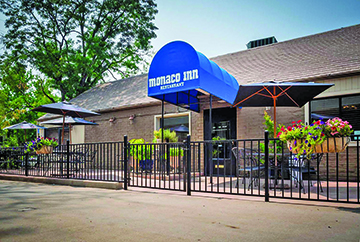
by Mark Smiley | Apr 21, 2022 | Main Articles
by Glen Richardson

Mom’s Special Day: After all the love, care, and cooking, Mother’s Day 2022 is just around the corner. Things to do range from music concerts and special menus at restaurants to high tea and Mother’s Day runs.
There’s a saying: “Life doesn’t come with a manual; it comes with a mother.
A teacher and a friend, she also takes care of the needs of the entire family. After all the love, care, and cooking, mom’s special day is just around the corner on Sunday, May 8.
Here’s the Chronicle’s choice of ways to celebrate with music concerts and special menus at restaurants, plus more to make Mother’s Day memorable:
Moms & Music
Brunch With Beethoven: Make your mom feel special this year by taking her to the Mother’s Day Brunch with Beethoven at Grant-Humphrey’s Mansion on Pennsylvania St., 8 a.m. to 3 p.m. Gourmet menu is from Chef Dane’s Kitchen on Gilpin St. Guests will enjoy Eggs Benedict, Tartines, Vegetable Quiche, Blueberry Rosemary Scones, Peach & Ginger Parfait, and Fruit Plate while listening to classical piano and a violinist. There will be a craft area for kids — ages 4 to 10 — to make a gift for mom. Information: 303-803-3727.
Mother’s Day Rock & Roll: Let mom and the kids move, play, and sing while listening to the music of the Beatles for kids. Bash is at the Bluebird Theater on E. Colfax Ave., 11:30 a.m. Information:303-377-1666.
Whitney Houston Tribute Brunch: Take mom to a musical tribute to Whitney Houston with singer Mary Louise Lee and her band in Centennial, 3 to 7 p.m. The event is at Piney Creek on E. Ida Dr. with brunch by Two Sistah’s Catering. Brunch includes Belgian Waffles, Scrambled Eggs, Potatoes O’Brien, Bacon, Turkey Sausage, Sweet Potato Coffee Cake, and Blackberry Cobbler. Information: 303-433-1000.
Brunch & Dinner
 Valley restaurants are hoping mom’s holiday 2022 will be a turnaround milestone in the pandemic age of economic recovery. Typically, Mother’s Day is one of the busiest times of the year. Nationally, reservations are running nine times higher than last year.
Valley restaurants are hoping mom’s holiday 2022 will be a turnaround milestone in the pandemic age of economic recovery. Typically, Mother’s Day is one of the busiest times of the year. Nationally, reservations are running nine times higher than last year.

Mother’s Day Magnet: The Monaco Inn Restaurant, a holiday hot spot for decades, is bringing back Mother’s Day. Serving from 3 to 9 p.m., specials include New York Steak and Fried Shrimp.
Monaco Inn Restaurant: Highlighting the turnaround is an announcement by this longstanding holiday hot spot that it will bring families together again for Mother’s Day, serving from 3 p.m. to 9 p.m. A dining experience like no other featuring Lamb Shank, Lamb Chops & Grilled Shrimp, New York Steak & Fried Shrimp, and Grilled Trout. The regular dinner menu is also available. Information: 303-320-1104.
Bistro Vendome: Chef Ariana is creating specials to serve alongside full menus for brunch 9 a.m. to 2:30 p.m. and dinner 4 p.m. to 10 p.m. Information: 303-825-3232.
Capital Grille: Downtown eatery on Larimer St. is opening early and serving their full dinner menu, as well as three brunch features from 11 a.m. to 2 p.m. Brunch choices are a Lobster Frittata, a 14 oz. Bone-In NY Steak & Eggs, or an 8 oz. Center Cut Filet Mignon. Information: 303-539-2500.
Carmine’s On Penn: Share a family feast at an Italian eatery offering to feed Mom with a family of 4-6 people. Deal includes Chicken Parmigiana, Meatballs, and a magnum bottle of wine. Information: 303-777-6443.

Brunch With Beethoven: One of this year’s special events is a catered music brunch at Grant-Humphrey’s Mansion from 8 a.m. to 3 p.m.
Citizen Rail: Restaurant in the Kimpton Hotel born on the 16th St. Mall has an all-you-can-eat brunch buffet with pastries, seafood, plus an omelet and prime rib station. Information: 303-323-0017.
Inga’s Alpine Tavern: Treat Mom at this hip holiday space in Glendale on Leetsdale Dr. offering full menu, 11 a.m. to midnight. The man of 1,000 songs Rob Wivchar entertains mom, kids & family. Information: 720-389-6203.
Jimmy’s Jersey St. Café: Eatery off of 9th Ave. & Colorado Blvd. is serving Roast Tenderloin & Fresh Seafood buffet. Choose from 10 a.m., noon, and 1:30 p.m. seating times. Information: 720-328-9481.
Ritz-Carlton: The Five Diamond hotel on Curtis St. is featuring an elaborate brunch buffet, a mimosa bar, plus a kids buffet. Families will receive a portrait to take home. Information: 303-312-3800.
Cooking Class

For Food Lovers: Consider treating moms that are connoisseurs of food to a Mother’s Day cooking class at Stir Cooking School.
Stir Cooking School: Take Mom to this Highlands neighborhood school for a Mother’s Day British Brunch Class, 1-4 p.m. A French Macaron Class is also offered. Information: 720-287-4823.
Tea Time
Mother’s Day Afternoon Tea: Babe’s Tea Room on 15th St. — next to Sushi Sasa — is offering Mother’s Day tea May 2-8. Featuring tea sandwiches, miniature scones, Scottish shortbread, French macarons, and a Bouquet of Pastry topped with a tier of Mother’s Day desserts. Information: 303-455-4832.
Tea At The Palace: Impress mom by taking her to the Brown Palace for afternoon tea, 11 a.m. to 4 p.m. She’ll enjoy herbal teas, scones, and finger sandwiches to the soft sounds of a harpist or pianist in the luxury setting. Information: 303-297-3111.
Tea At Le Rêve: Take mom to this intimate Cap Hill space on E. Colfax — French for Sugar — for an afternoon of luxury teas, noon to 2 p.m. Serving sandwiches and desserts. Information: 303- 522-6886.
Yoga With Mom
Morning Yoga: Nui Mani Yoga is offering a Mother’s Day yoga class at the Kentucky Inn on S. Pearl St. taught by Davina Lochi. Moms will be treated to a complimentary mimosa or bloody mary following the class. Information: 303-777-7550.
Mother’s Day Runs
Run For MS: Join the MS Relay America in partnership with Boulder Running Co. at the Cherry Creek Shopping Center for the 5K or 10K run plus a post-run brunch, 9 a.m. Information: 303-847-4123.
City Park 5K: The starter’s gun goes off at 9 a.m. for this year’s Mother’s Day 5K. Flippin’ Flapjacks cooks pancake-sausage breakfast for participants. Information: runsignup.com.

by Regan Bervar | Apr 21, 2022 | Main Articles
“What can oppose the decline of the west is not a resurrected culture but the utopia that is silently contained in the image of its decline.”
 by Luke Schmaltz
by Luke Schmaltz
On the evening of April 5, 2022, Lowry United Neighborhoods (LUN) hosted a town hall meeting at Eisenhower Chapel to address widespread concerns about issues stemming from Denver’s unhoused problem.
The panel of speakers represented a cross section of agencies and organizations working directly and otherwise to have a positive impact on the unhoused crisis. The panelists included:
- HOST (Housing Stability and Homelessness Resolution): Deputy Director, Angie Nelson
- Denver City Attorney’s Office: Director of Prosecution and Code Enforcement, Marley Bordovsky
- Salvation Army: Major Richard Pease and Denver Metro Social Services Director Christine Baluyot
- STAR (Support Team Assisted Response): Operations Manager, Carleigh M. Sailon
- Colorado State Senator, District 31, Chris Hansen
Additionally, Denver City Councilwoman Amanda Sawyer (District 5) was on hand to answer questions and offer commentary.

STAR (Support Team Assisted Response) responds to non-violent 911 calls in place of police officers.
The briefing for the meeting stated: “LUN presents this discussion because of widespread frustration that millions of dollars and years of work have brought only fragmented remedies. Along with homelessness, comes health and safety impacts harmful to those who live on the streets, as well as to other citizens of Denver.
“LUN has assembled this panel of local leaders to help us better understand the challenges for the homeless and unhoused in our city and for the agencies who serve them. The panel will discuss the spectrum of services and housing options designed to assist unhoused individuals in Denver and what those efforts have achieved.”
Denver7 Reporter Russell Haythorn acted as discussion moderator. The following is a condensed version of the 90-minute meeting, highlighting some (but not all) key points made by each speaker.
Angie Nelson — Housing Stability and Homelessness Resolution
The HOST Deputy Director holds a master’s degree in social work as well as a bachelor’s degree in pre-professional counseling. Administrators appointed Nelson to her position in March of 2021. Nelson was thorough in explaining the scope of the unhoused issue and laid out, in great detail, what her organization and others working in this field are up against. “We invest resources and help to create policies and empower partnerships to help across the whole spectrum of homelessness through housing opportunities” she began. “We are helping keep folks in the homes they have through programs such as rental assistance, utility assistance and home repair and modification. We help to quickly resolve episodes of homelessness through a variety of programs such as street outreach and shelters to programs such as supportive housing. Some of our key performance measures are that we hope to see a 50% reduction in unsheltered homelessness in the next five years.”
Moderator Russell Haythorn (questions relayed from audience members): “How does HOST control, monitor, and enforce policies regarding substance abuse and also, does HOST help connect its clients with resources for mental health and substance abuse treatment?”
Angie Nelson: “Within our programs we seek to make sure there is a holistic response. So, our housing programs aren’t housing only, they are housing first, but they are also there to support services that are going to help someone meet their needs when it comes to mental health or substance abuse so that people have the support they need to get stable and stay stable.”
Marley Bordovsky — Denver City Attorney’s Office
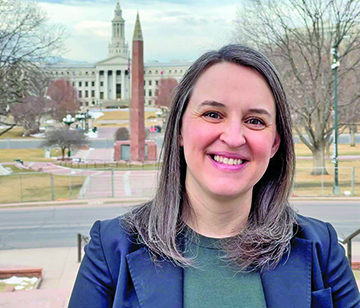
Angie Nelson is Deputy Director of HOST and is contending with a massive, complicated issue.
Moderator Russell Haythorn: “Under what circumstances does the City Attorney’s Office become involved with individuals who are experiencing homelessness?”
Marley Bordovsky: “I am at a cleanup most every day of the week to make sure our city agencies are solid in how they are conducting themselves and making sure they are abiding by all the settlements they have to abide by,” she began. “So, we provide boots on the ground legal guidance for the city agencies involved in the process. I want to highlight … a lot of our specialty dockets that are instrumental in crafting and creating with our court partners and city partners and also in staffing with attorneys. We have an outreach docket that we staff every other Wednesday. It started at the Denver Rescue Mission where we actually held court during Covid. The concept is to bring the court to where you are. It’s one thing to say, ‘You need to be in court on this day and if you’re not here we’re going to issue a warrant for your arrest.’ A lot of folks can’t make it down to the courthouse for a lot of reasons, whatever it might be, so this is an attempt to bring court to you so that it is a much lower barrier. We have a wellness docket that is a way to divert you out of the criminal justice system. There is a court component of it, where if you have outstanding warrants, we can help clear those warrants for you so you’re not getting arrested and going back into the cycle.”
Bordovsky supplied attendees with a two-sided handout explaining the complexities, constraints and parameters that most workers must follow when conducting cleanups of public encampments. “ For the cleanups we do three times a week in general around the city, there are some serious legal constraints that we abide by,” she began. “We have to post a large-scale cleanup for seven days minimum. It’s very structured as to how that posting is done. [Notices] are put on the tent, put around the perimeter, we have to define the perimeter of the area we are cleaning up. On the back of it is always the services that Angie’s team (HOST) provides for folks if they are interested.”
The Salvation Army — Major Richard Pease and Denver Metro Social
Services Director Christine Baluyot
Major Richard Pease offered a brief summary of his organization before answering questions. “We are an international organization,” he began, “But here in the United States (last year) we touched the lives of about 25 million Americans through our social services programs, which means nationally, outside of the Federal government, we are the largest provider of social services in the U.S.”
Moderator Russell Haythorn: “Describe specific programs and intended outcomes for those experiencing homelessness.”
Richard Pease: “In Denver, we have a family shelter called the Lambeth Family Center which is in west Denver. It currently has 20 units for families experiencing homelessness. It’s a 90-day program with the intent of getting folks stabilized in their housing. From day one they meet with case managers to help them get to permanent stable housing. About 74% of families who enter into our programs exit into stable housing which is well above that national norm for that type of program. We are in the process of developing an expansion on Alameda (we call it the Alameda Campus) that will include a new, state-of-the-art 85-unit program for families. Our goal is to get that built and open by the end of 2024.”

Lowry United Neighborhoods (LUN) is the official RNO (Registered Neighborhood Organization) of the district.
Christine Baluyot: “Some things we have learned about successfully moving people who are unhoused into stable or permanent housing are [in] the Denver Housing Collaborative. This is a really exciting approach that is really innovative. It’s a partnership between HOST and a few different organizations here in Denver (Colorado Coalition, Urban Peak, and others). We had this [big] increase in people experiencing homelessness, filling up hotels, taking up shelter beds, and we were not able to move them out. It [the Collaborative] came about as a result of a conversation between all of us partners and the city. As a result, we have been provided the funding to have case management teams, housing navigation teams — all of us working together as a collective which has never happened before. There is funding to be able to get people directly into housing and it is not tied to a lot of the restrictions of most of the Federal funding we get.” Baluyot went on to explain why this particular type of funding versus Federal funding is so effective — because it is available immediately and can be implemented with expediency. “This is the key reason as to why Crossroads has been so successful in getting people into housing, because we can say, ‘Hey, do you want housing? They say yep and the next week, they are in housing.’”
STAR (Support Team Assisted Response) Operations Manager Carleigh M. Sailon
Moderator Russell Haythorn: “Tell us about STAR and what initiatives STAR is involved in.”
Carleigh Sailon: “STAR [is] a civilian response program that pairs a mental health clinician with a paramedic or EMT and they are dispatched to low-risk, low-acuity calls coming into the 911 system. While we are not just a homeless outreach team, we focus on resource requests, transportation requests, behavioral health issues, substance abuse issues — anyone who is experiencing some sort of crisis in the city and county of Denver and calling 911 or police non-emergency for assistance with that crisis. About 60% of the individuals we have responded to in the last month have been unhoused. When a call comes into the 911 communication center, it screens for risk. Is there a weapon, is there an injury, is there a time-sensitive issue where we have to send an armed response? Or is someone safe enough to wait for a non-emergent response? Is there a public safety issue? Has a crime been committed? If all those answers are no, then our civilian call-takers and dispatchers can start thinking about if STAR should be sent. While police, fire, or EMS are sometimes the right answer, they are not always the right fit for every scenario. [We are] trying to send folks who have the appropriate expertise [for] the issues we are facing.”
Colorado State Senator Chris Hansen
Moderator Russel Haythorn: “Do you agree that Denver and Aurora carry the primary budgetary responsibility for providing housing and services for those experiencing homelessness?
Senator Chris Hansen: “There is an important state role that is being played in responding to this crisis we are in. We have built a system that has a lot of local governments being the front door for providing services, but the state has a super important role to play. I have the job of leading the state Senate on the Joint Budget Committee and the Senate Appropriations Committee. We are making some very big budgetary decisions and I have some great news to share with everybody tonight. There is a very large response from the state budget to help local governments — Aurora,
Denver, etc. It is a statewide crisis, and we are trying to respond to that in a statewide way. In this budget, we have set aside 200 million dollars for addressing the crisis directly. About half of that is going to end up coming to Denver and Aurora. On top of that, accommodation of state funds and Federal AARPA dollars, the relief act that was passed last year, Colorado received about four billion dollars. We are going to be using about a quarter of that for mental health supports, behavioral health supports, addiction services and housing programs across the spectrum. So, the state is taking some comprehensive steps in this budget.”
Denver Councilwoman Amanda Sawyer, District 5
Moderator Russell Haythorn: “Given that the city has provided funds for the Denver Rehousing Collaborative, are you tracking subsequent reduced costs in GDPR visits, vagrancy, an
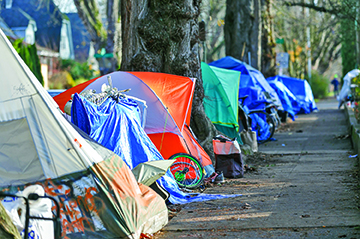
Marley Bordovsky of the Denver City Attorney’s Office explained the complexities of conduction sweeps of homeless encampments in Denver.
d has there been enough data? What are you seeing?
Councilwoman Amanda Sawyer: “This is a huge issue and what you’ve heard tonight is probably a third of what actually goes on behind the scenes in terms of all the different programs, responses, and opportunities that there are. In terms of the question that was asked, we don’t have the data yet to show whether it’s working or not. I will tell you, the most incredibly frustrating thing for us is when we see no response at all or a slow response when it feels like it should be a quick fix. It feels like it should be something very simple, and we make it a lot more complicated on the governmental level. Things are so siloed, organizations aren’t talking to each other, I know you feel that, and we feel it too — especially when we hear from someone who is unhoused [say] ‘I was unhoused in Greenwood Village and they gave me a bus ticket to Denver.’ I think what you have heard tonight is the start of real solution-oriented conversations. We know there are a number of residents experiencing homelessness who need mental health support services. There just aren’t enough beds in the state for them. We know there’s a portion of people who need long-term substance abuse recovery support. There aren’t enough beds. But the conversation is starting and at the end of the day the city doesn’t have the financial resources to solve homelessness on our own. We have to have state support. We have to have federal support. Right now is an extraordinary time because we have that funding available. We don’t have the data yet to show this is working. It’s gonna take time to build more facilities and more beds. Senator Hansen mentioned there is a 250-bed program that is working really well. We have approximately 4,000 homeless residents in Denver. We would need 16 of those facilities to be able to support the homeless community.”


























